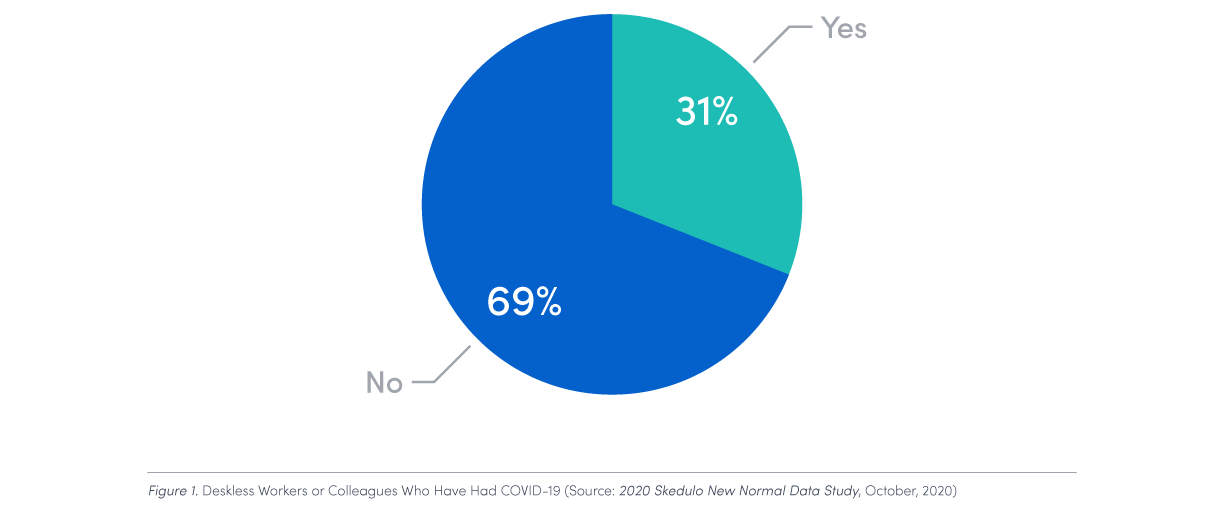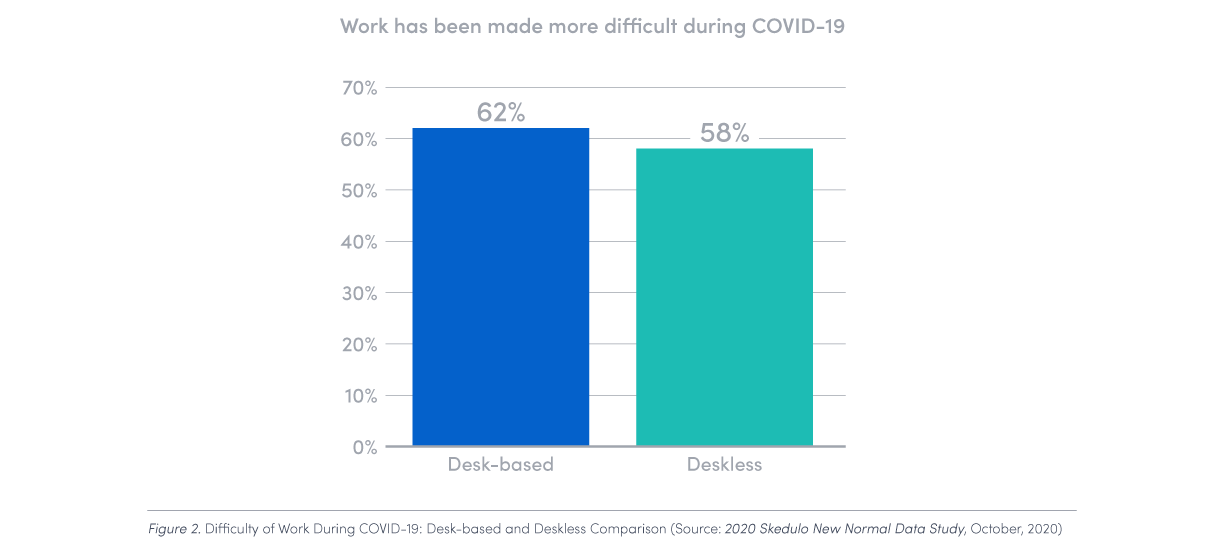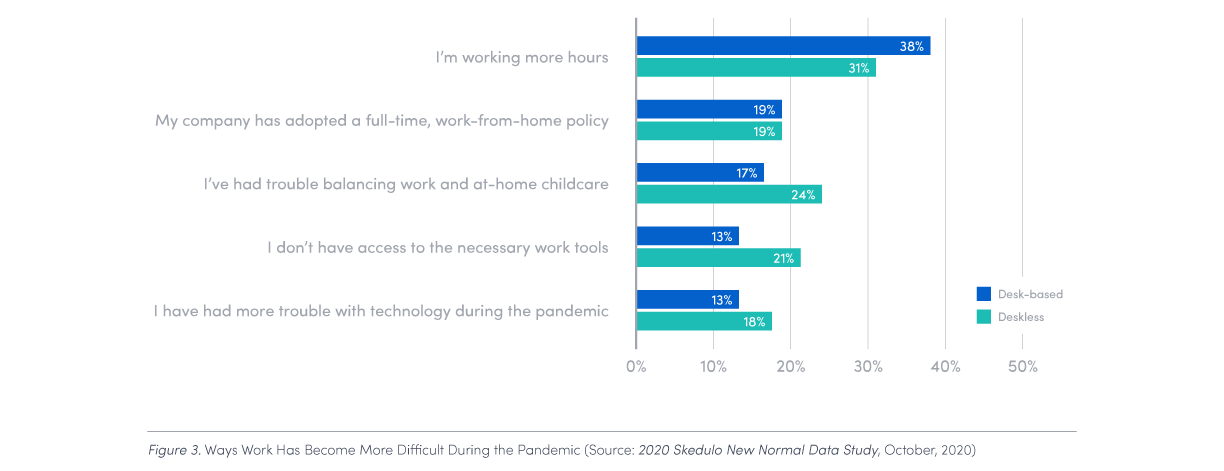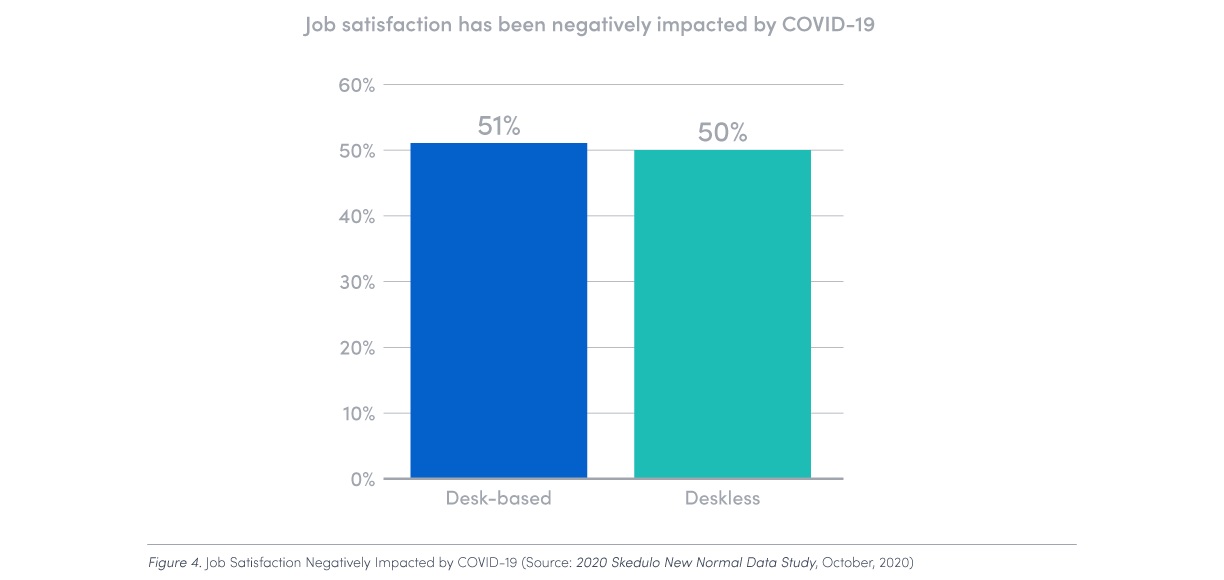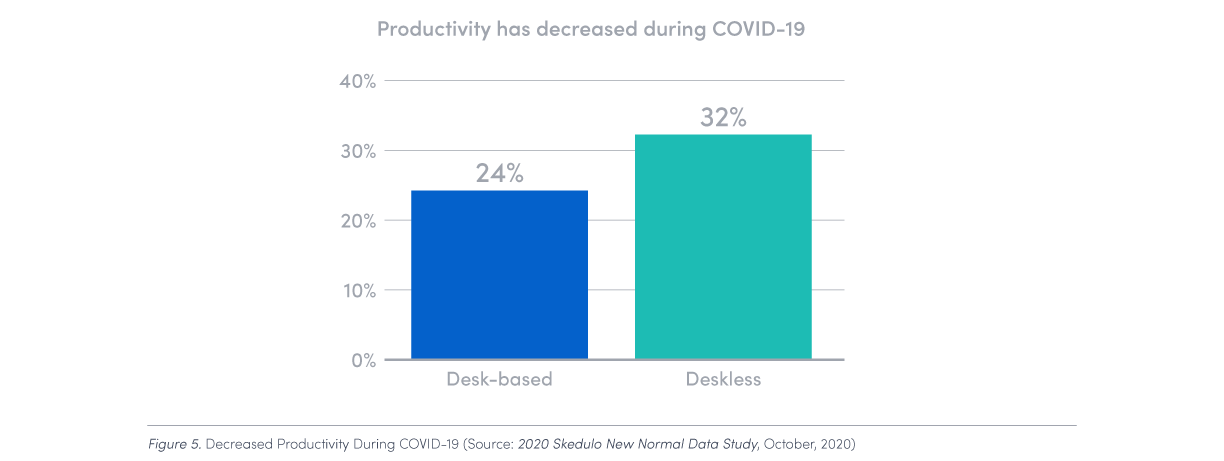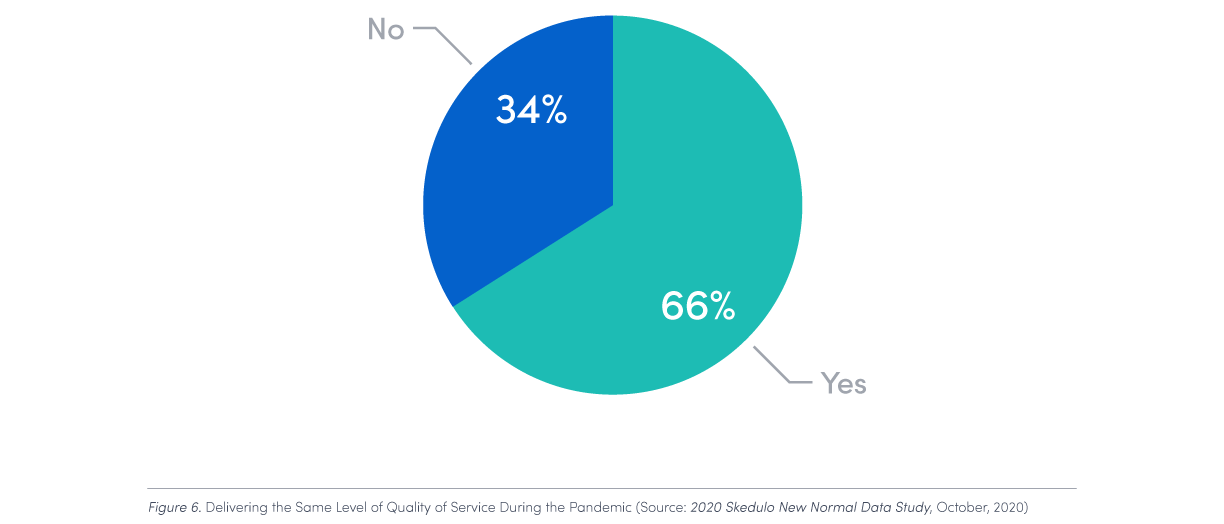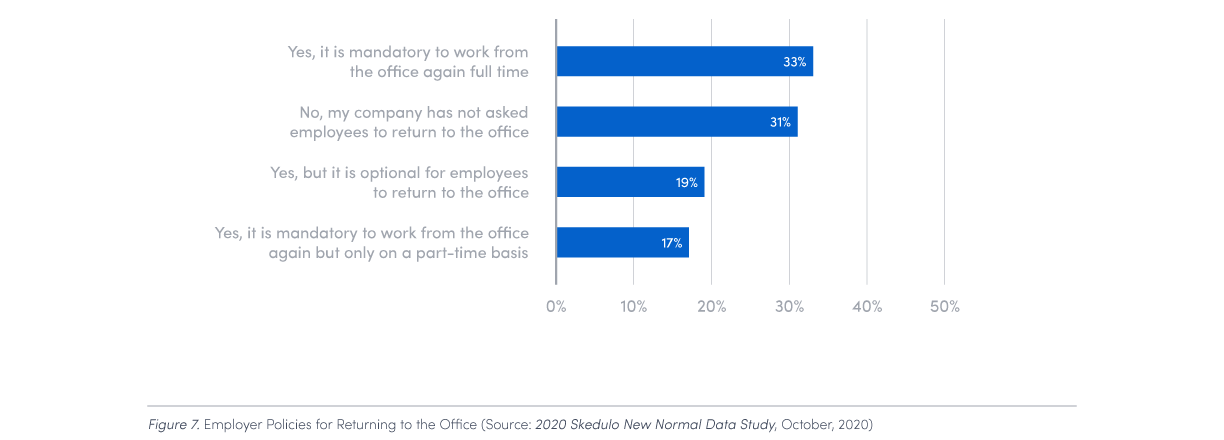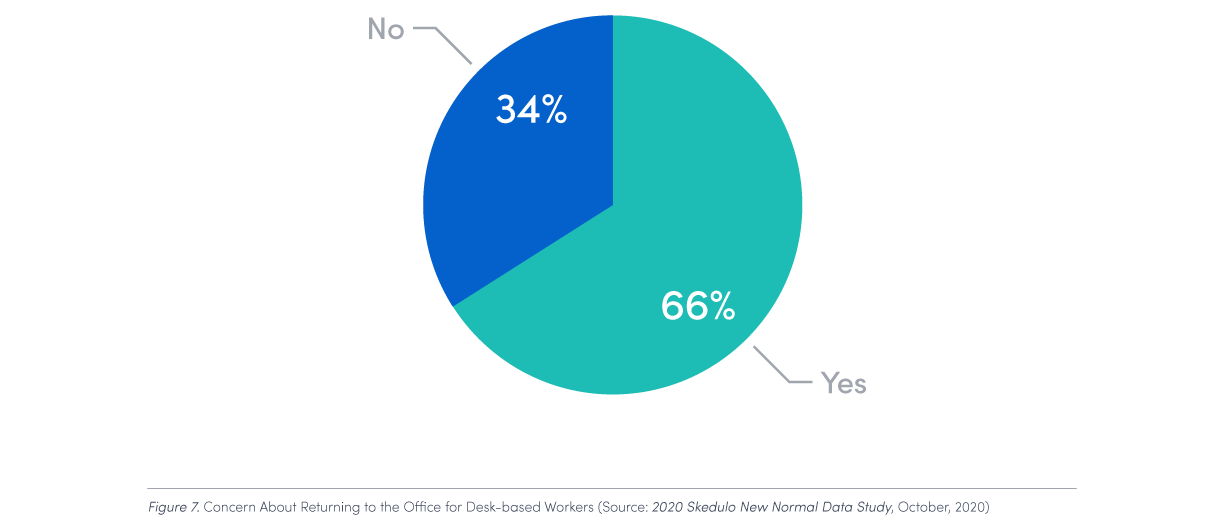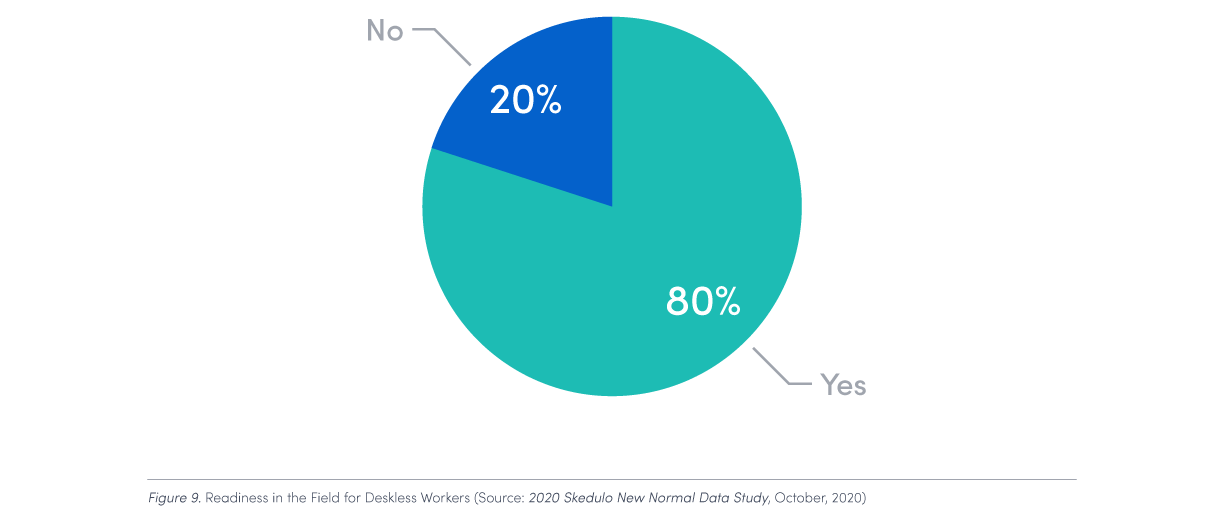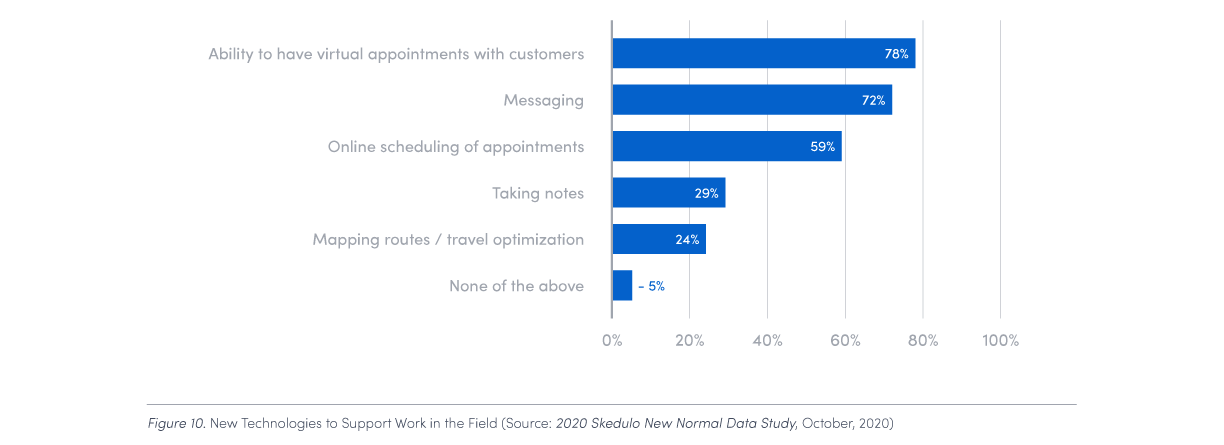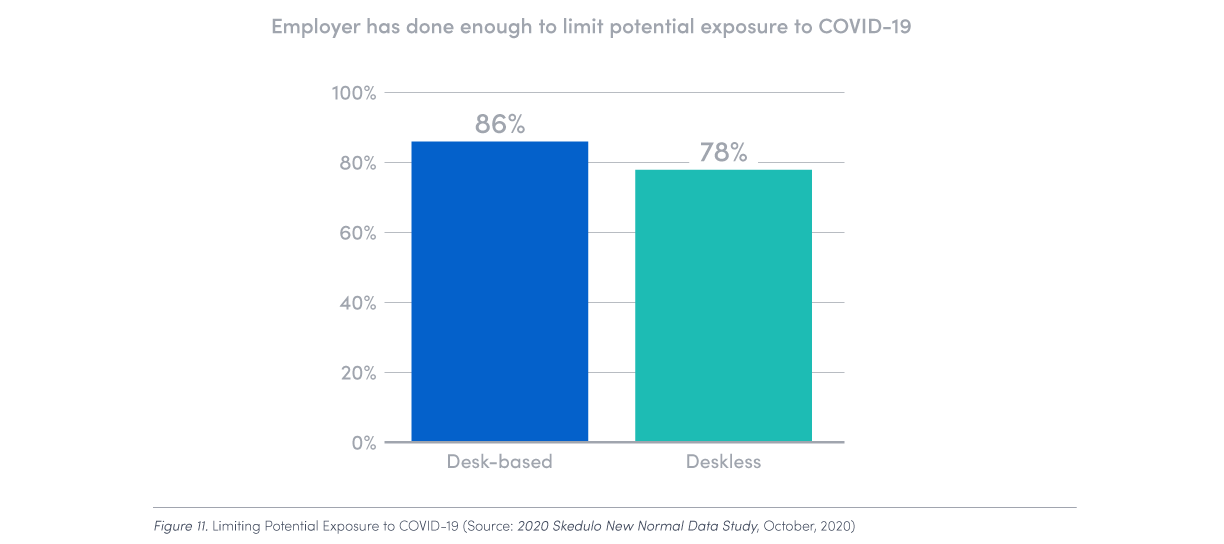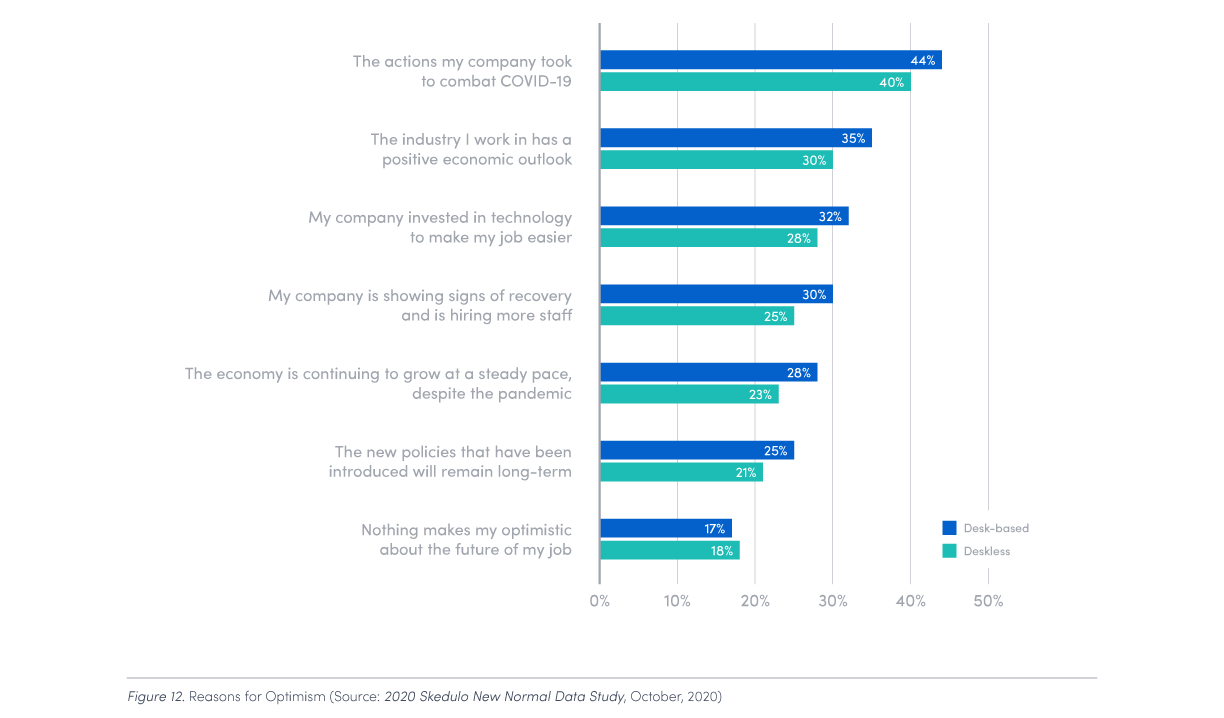Nearly 1-in-3 deskless workers have themselves or have a colleague who has suffered from COVID-19 as a result of being in the field.
International Snapshot: This rate of deskless workers who have directly contracted COVID-19 or knew a colleague who had was highest in India (54%) where the virus has been widespread and the lowest in Australia (14%) where strong restrictions are in place.
But you don’t have to contract COVID-19 at work to have felt the pandemic’s impact. COVID-19 has made work more difficult for employees worldwide. The majority of workers (60%) feel that work has been more difficult during COVID-19, and this figure is very similar for desk-based workers at 62% and for deskless workers at 58% (Figure 2).
International Snapshot: Respondents from India are more likely to feel COVID-19 has made work more difficult at 78% of desk-based workers and 72% of deskless workers, whereas Australians are least likely to feel this way at 44% for desk-based workers and 43% of deskless workers.
The main reason why work has become more difficult, according to both desk-based and deskless workers, is an increase in work hours. Other often-cited reasons include trouble balancing work and at-home childcare, adoption of full-time work-from-home policies, and lack of access to necessary work tools (Figure 3).
With work becoming more difficult, it’s no surprise that COVID-19 has had a dramatic effect on job satisfaction for all workers. Fifty-one percent of all workers say their job satisfaction has been negatively impacted by COVID-19, and this reduced job satisfaction is being felt by both deskless workers (50% of whom are less satisfied), and desk-based workers (51% of whom are less satisfied). (Figure 4) More work due to companies letting people go or furloughing employees and not receiving a planned raise or promotion due to cost cutting are the top reasons for negative job satisfaction during the pandemic.
COVID-19 Has Had a Customer-facing Impact
With all the challenges brought on by the pandemic, employees have had to adjust the way they work, with 28% of all workers saying their productivity has decreased during the pandemic. There has been a greater impact on deskless workers, with 32% saying their productivity has decreased, than desk-based workers at 24% (Figure 5).
Working hours have increased during the pandemic for 33% of all workers.
The gap in productivity is predominately made up by the sheer effort of working more hours. Thirty-three percent of all workers say their working hours have increased during the pandemic with desk-based workers taking on the bigger increase at 37%. However, this extra effort may not be a sustainable approach to doing business successfully, and frontline workers are already seeing the strain on their ability to service customers to pre-pandemic expectations. This is having an impact on customer service, with 34% of deskless workers stating that quality of service has been negatively impacted during COVID-19 (Figure 6).
Businesses Are Taking Action to Help Employees
In the face of the many challenges brought about by COVID-19, companies, IT departments, and workers have rallied to adapt. One key focus is instituting policies and procedures to help bring employees safely back to the office. Already 50% of desk-based workers have returned to offices with 33% of their companies implementing mandatory requirement to work from the office full-time and 17% mandating they be in the office part-time (Figure 7).
However, businesses cannot simply hope employees are willing or able to operate in the same way they used to. Nearly 2/3 of desk-based workers (66%) have concerns about returning to work (Figure 8). The rate of concerned workers jumps to 75% for those whose company has a mandatory work from the office policy. Returning to the office also correlates with job satisfaction as 64% of desk-based workers whose employers have a mandatory work-from-office policy have said that job satisfaction was negatively impacted by COVID-19, much higher than the 51% across the entire study.
Fortunately, most employers have taken action to implement new safety policies as a result of the pandemic including wearing face masks at all times, social distancing, and new personal time off policies. Furthermore, businesses have provided deskless workers with new tools to help them be successful as their jobs working in the field have changed. Most deskless workers (80%) feel they have the tools necessary to complete their jobs (Figure 9).
A large number of these tools have been newly implemented as a result of the pandemic. Deskless workers state that nearly 3/4 of employers (73%) have implemented new technology to help deskless workers during the pandemic. In particular, the need for communication and scheduling tools spiked during the pandemic. CIOs indicate the leading technologies their organizations have invested in during the pandemic to support workers in the field are virtual customer appointments tools (78%), new messaging tools (72%) and online appointment scheduling (59%). (Figure 10)
International Snapshot: Countries leading in the adoption of new tools to support deskless workers include India (95%) and the U.S. (76%). The UK and Australia both lag at 62% apiece.
Employees Are Optimistic for the New Normal
Implementing these new policies, procedures, and new technology is paying off, with employees feeling more confident about their own safety, and optimistic for the future of their businesses. Seventy-eight percent of deskless workers and 86% of desk-based workers feel their employer has done enough to limit their potential exposure to COVID-19 (Figure 11).
Forty-two percent of workers say they are optimistic about their jobs due to the actions their employers took during the pandemic. Their main reasons for optimism include technology investments that make their jobs easier, a positive economic outlook for their industry, and signs their company is recovering and hiring more staff (Figure 12).
Key Takeaways/Guidance
Working more hours is not sustainable.
Employees are working hard to continue to deliver quality service to their customers, even as a significant 32% of deskless workers and 24% of desk-based workers are seeing productivity decrease. As their jobs have become more difficult, they are striving to meet customer expectations largely through effort. Both desk-based (38%) and deskless workers (31%) cite working more hours as the top reason why their jobs are more difficult. And as more work due to companies letting people go or furloughing employees is the top reason for negative job satisfaction, longer hours and greater pressure on employees in difficult work environments is not sustainable as a long-run strategy.
Businesses should take action that supports employees and helps improve productivity.
As more employees return to the office and deskless workers serve customers in the field, organizations need to continue investing in the tools and technologies to keep employees safe while helping them perform more efficiently. Virtual appointments and service offerings (78%) and messaging tools (72%) are the top investments organization made to help employees and to improve customer experience.
Accelerating digital transformation has been a silver lining during the pandemic.
Better communication and scheduling have been necessary to address fundamental customer service and employee productivity challenges during the pandemic. As technologies like virtual appointments and online scheduling provide a safe and effective solution, organizations, IT decision makers, and individual employees have been forced to accelerate their digital transformation. This has been a silver lining in an otherwise difficult time. Adopting these technologies now has not only aided productivity and customer service during the pandemic but can continue to support growth over the long term. Employees agree, as 32% of workers say they are optimistic about their jobs due to the technology investments that have made their jobs easier during the pandemic.
Scheduling tools are needed.
As businesses work to get employees back in the office and in the field, a key tool in supporting the new normal is scheduling. While the study shows that 38% of companies have invested in new online scheduling tools during the pandemic, there is substantial room for improvement. Manual scheduling can lead to missed appointments and unhappy customers. Organizations need an easy way to manage job queues and schedule daily work and appointments, including selecting the right employee based on job requirements and coordinating factors like availability and travel time.
Download the full report:
About This Research Study
Skedulo performed a web-based survey of 1,336 employees made up of 626 deskless workers, 610 desk-based workers, and 100 IT executives in October 2020. Respondents were primarily from 4 countries: United States (642 respondents), India (262), United Kingdom (235), and Australia (188), and other countries (9). Respondents represented a range of organizational sizes across a representative spectrum of industries.
About Skedulo
Founded in 2013, headquartered in San Francisco and with offices in Australia, Vietnam, and the United Kingdom, Skedulo has enabled hundreds of organizations, including The American Red Cross, DHL, and Sunrun to seamlessly schedule and service more than 5 million appointments around the globe. Skedulo’s leading Deskless Productivity Cloud empowers organizations to manage, engage and analyze their deskless workforce and is built to integrate with business-critical systems including Salesforce, Zendesk, ServiceNow, Workday, Epic Systems, and multiple electronic health record (EHR) solutions through a partnership with Bridge Connector. The company has secured more than $40 million in funding to date, led by M12, Costanoa Ventures, and Blackbird. For more information, please visit www.skedulo.com, or our blog, @Skedulo, Facebook and LinkedIn pages.

